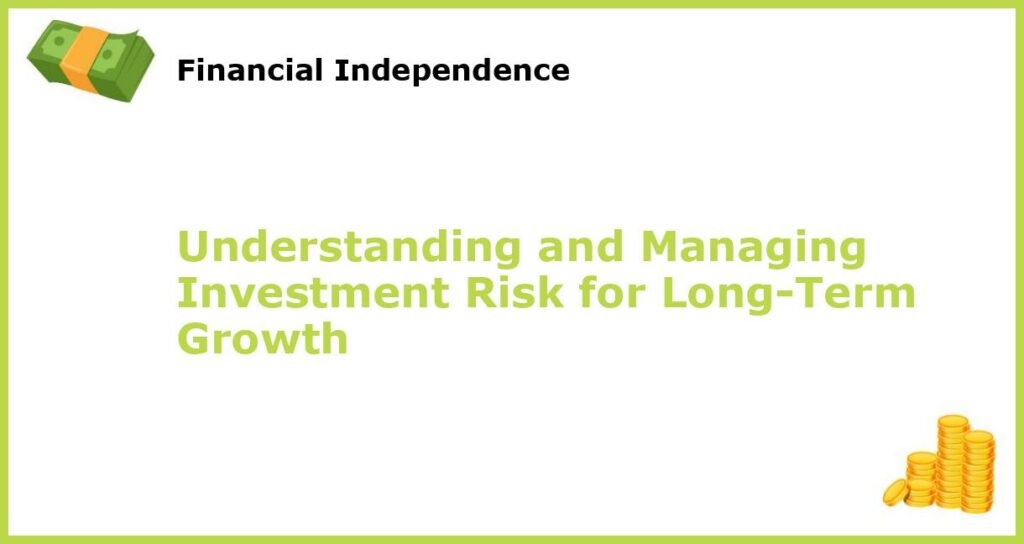Investing can be a powerful tool for growing your wealth over the long-term, but it does come with risks. These risks can manifest in a variety of ways, from the overall performance of the market to fluctuations in interest rates or the potential for inflation to erode the value of your investments. Understanding these risks and how to manage them is critical if you want to achieve your long-term financial goals.
The Importance of Understanding Investment Risk

Investment risk refers to the potential for investors to lose money as a result of circumstances beyond their control. This can take many forms, but the most common risks include market risk, inflation risk, interest rate risk, credit risk, and liquidity risk. By having a clear understanding of what these risks are and how they can impact your investments, you can make more informed decisions and learn how to manage them in a way that maximizes your returns while minimizing exposure to risk.
Market risk, for example, refers to the potential for your investments to lose value due to overall market conditions, whereas interest rate risk is related to changes in interest rates over time. Credit risk, on the other hand, is the risk that borrowers will default on their loans, and liquidity risk refers to the potential difficulty in selling assets quickly or at a fair price.
The Different Types of Investment Risk

It’s important to note that these risks can all interact with each other in different ways. For example, inflation can lead to higher interest rates, which in turn can impact the overall performance of the stock market. As a result, it’s important to have a diversified portfolio that takes into account the various types of investment risk, as we’ll discuss below.
The Importance of Diversification

One of the most effective ways to manage investment risk is to diversify your portfolio. Diversification refers to investing in a variety of different assets and asset classes, rather than putting all of your money into a single stock, bond, or other investment. By spreading your money around, you can minimize your exposure to any one type of risk or asset class, which can help protect your wealth over time.
For example, if you only invest in the stock market, you’ll be subject to potentially significant losses if there’s a market downturn. However, if you also invest in bonds and real estate, you can help balance your portfolio and reduce your risk exposure across different types of assets.
The Role of Asset Allocation

Another important tool for managing investment risk is to implement an effective asset allocation strategy. Asset allocation involves deciding how to divide your investments across different asset classes based on your individual risk tolerance, financial goals, and investment time horizon.
For example, a younger investor with a longer investment horizon might consider a more aggressive allocation that’s heavily skewed towards stocks, while an older investor closer to retirement may opt for a more conservative mix that includes more bonds and cash holdings. Diversifying your investments across different assets and using an appropriate asset allocation strategy can help to minimize your overall risk exposure while still pursuing potentially lucrative investment opportunities.
The Importance of Monitoring Your Portfolio

Monitoring your portfolio regularly is also critical for success as an investor. This involves checking on your portfolio’s performance, making adjustments as needed, and rebalancing your holdings as necessary. As market conditions change, the performance of different asset classes can fluctuate, which means that your portfolio may need to be rebalanced to maintain your desired allocation and risk exposure.
By conducting regular portfolio reviews and adjustments, investors can be sure they’re staying on track towards their long-term financial goals. This can help reduce the risk of significant losses and positions investors for greater success over time.
The Benefits of Patience and Long-Term Thinking

Investing is a long-term endeavor, and taking a patient and disciplined approach is key to managing risk effectively. While the market can be volatile in the short-term, focusing on your long-term goals and sticking to your investment plan can help you ride out the ups and downs of the markets and build wealth over time.
It’s important to remember why you’re investing in the first place, whether that’s for retirement, financial independence or for other long-term goals. Keeping this larger perspective in mind can help you stay the course when the market is performing poorly, avoiding the temptation to make impulsive or emotionally-driven decisions that could lead to significant losses.
The Importance of Seeking Professional Advice

If you’re new to investing or find the subject matter complex or intimidating, it can be helpful to seek professional advice. A financial advisor can help you assess your risk tolerance, define your financial goals, and create a personalized investment plan tailored to your needs and circumstances.
An experienced advisor can also provide education and guidance on a range of topics, from asset allocation and diversification to market analysis and risk management. This type of guidance can help you manage your investments with greater confidence and positioning you for greater success over the long-term.
The Role of Diversified Investment Products

Beyond diversifying across different asset classes, there are also diverse ways to invest across various investment products. For instance, you can use mutual funds and exchange-traded funds (ETFs) to bring diversified portfolios under professional management. Additionally, insurance products like annuities can shield your capital while still participating in market growth, among other options.
Knowing your investment goals and risk tolerance, consulting with an advisor, and diversifying your investments through various investment products can be effective ways to balance your risk exposure and maximize your long-term investment returns with sound investment management.
The Importance of Staying Educated

The investment landscape is continually shifting, so it’s vital to stay up-to-date on the latest trends and changes affecting the markets. Investors should stay well-informed through financial news and media, educational seminars, and market insights from investment professionals. This can help you to make informed decisions about your investments and remain informed over time as new opportunities arise or conditions change.







